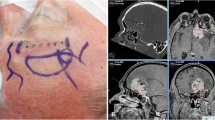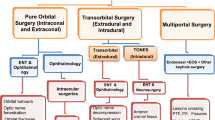Abstract
Purpose
Access to the space behind the eyeball is limited by the position of the globe anteriorly, the neurovascular structures embedded in fat posteriorly, and the tight bony confine of the orbit. These anatomical relationships have impeded application of minimally invasive procedures to the region, such as foreign body removal, tumor biopsy, or the administration of medical therapy directly to the optic nerve. An image-guided system was developed using a magnetically tracked flexible endoscope to navigate behind the eye, with the aim of enabling accurate transorbital surgery to user-specified target locations.
Methods
Targets were defined by microspherical bulbs containing water or gadolinium contrast, with differing visible coloring agent. Six living pigs were anesthetized and two microspheres of differing color and contrast content were implanted in the fat tissue of each orbit. Preoperative T1-weighted MRI volumes were obtained and registered intraoperatively. The system capabilities were tested with a series of targeted surgical interventions. The surgeon was required to navigate the endoscope to each lucent microsphere and identify it by color. For three pigs, 3D/2D registration was performed such that the target’s image volume coordinates were used to display its location on real-time endoscope video.
Results
The ophthalmologic surgeon was able to correctly identify every target by color, with average intervention time of 24.2 min without enhancement and 3.2 min with enhancement. This difference is highly statistically significant \((p < 0.02)\) for reduction in localization time.
Conclusions
Accurate transorbital target localization is possible in-vivo using image-guided transorbital endoscopy, while endoscopic enhancement through the use of video augmentation significantly reduces procedure time.






Similar content being viewed by others
References
Quigley HA, Broman AT (2006) The number of people with glaucoma worldwide in 2010 and 2020. Br J Ophthalmol 90:262–267
McKinnon SJ, Goldberg LD, Peeples P, Walt JG, Bramley TJ (2008) Current management of glaucoma and the need for complete therapy. Am J Manag Care 14:S20–S27
Levin LA, Peeples P (2008) History of neuroprotection and rationale as a therapy for glaucoma. Am J Manag Care 14:S11–S14
Lambert WS, Ruiz L, Crish SD, Wheeler LA, Calkins DJ (2011) Brimonidine prevents axonal and somatic degeneration of retinal ganglion cell neurons. Mol Neurodegener 6(4):1–14
Krupin T, Liebmann JM, Greenfield DS, Ritch R, Gardiner S (2011) A randomized trial of brimonidine versus timolol in preserving visual function: results from the low-pressure glaucoma treatment study. Am J Ophthalmol 151:671–681
Geroski DH, Edelhauser HF (2000) Drug delivery for posterior segment eye disease. Investig Ophthalmol Vis Sci 41(5):961–964
Balakrishnan K, Moe KS (2011) Applications and outcomes of orbital and transorbital endoscopic surgery. Otolaryngol Head Neck Surg 144(5):815–820
Mawn LA, Shen J-H, Jordan DR, Joos KM (2004) Development of an orbital endoscope for use with the free electron laser. Ophthalmic Plast Reconstr Surg 20(2):150–157
Atuegwu NC, Mawn LA, Galloway RL (2007) Transorbital endoscopic image guidance. In: Proceedings of the 29th annual IEEE engineering in medicine and biology society conference, pp 4663–4666
Stefansic JD, Bass WA, Hartmann SL, Beasley RA, Sinha TK, Cash DM, Herline AJ, Galloway RL (2002) Design and implementation of a PC-based image-guided surgical system. Comput Methods Programs Biomed 69(3):211–224
Ingram M-C, Atuegwu NC, Mawn LA, Galloway RL (2011) Transorbital therapy delivery—phantom testing. In: Proceedings of the SPIE medical imaging, vol 7964
Sielhorst T, Feuerstein M, Navab N (2008) Advanced medical displays: a literature review of augmented reality. J Disp Technol 4(4):451–467
Freysinger W, Gunkel A, Thumfart W (1997) Image-guided endoscopic ENT surgery. Eur Arch Otorhinolaryngol 254(7):343–346
Kawamata T, Iseki H, Shibasaki T, Hori T (2002) Endoscopic augmented reality navigation system for endonasal transsphenoidal surgery to treat pituitary tumors: technical note. Neurosurgery 50(6):1393–1397
Stefansic JD, Herline AJ, Shyr Y, Chapman WC, Fitzpatrick JM, Dawant BM, Galloway RL (2000) Registration of physical space to laparoscopic image space for use in minimally invasive hepatic surgery. IEEE Trans Med Imaging 19(10):1012–1023
Lapeer R, Chen MS, Gonzalez G, Linney A, Alusi G (2008) Image-enhanced surgical navigation for endoscopic sinus surgery: evaluating calibration, registration, and tracking. Int J Med Robot Comput Assist Surg 4:32–45
Liu WP, Mirota DJ, Uneria A, Otake Y, Hager G, Reh DD, Ishii M, Gallia GL, Siewerdsen JH (2012) A Clinical pilot study of a modular video-CT augmentation system for image-guided skull base surgery. In: Proceedings of the SPIE medical imaging, vol 8316
Atuegwu NC, Galloway RL (2008) Volumetric characterization of the aurora magnetic tracker system for image-guided transorbital endoscopic procedures. Phys Med Biol 53(16):4355–4368
Adbel-Aziz YI, Karara HM (1971) Direct linear transformation from comparator coordinates into object space coordinates in close range photogrammetry. In: Proceedings of the symposium on close range photogrammetry, pp 2–28
Bouguet J-Y (2013) Camera Caliberation Toolbox for Matlab (online). Available: http://www.vision.caltech.edu/bouguetj/calib_doc/index.html
Zhang Z (1999) Flexible camera calibration by viewing a plane from unknown orientations. In: Proceedings of the 7th IEEE international conference on computer vision, pp 666–673
OpenCV (2013) OpenCV, Open Source Computer Vision Library (online). Available: http://opencv.willowgarage.com/wiki
Acknowledgments
The authors would like to thank Amy Nunnally, Jamie Yates, and Phil Williams for their assistance with surgery, and Seth Smith with the Vanderbilt University Institute of Imaging Science for providing appropriate MR image sequences.
Conflict of interest
Michael DeLisi, Louise Mawn, and Robert Galloway declare that they have no conflict of interest. All institutional and national guidelines for the care and use of laboratory animals were followed.
Author information
Authors and Affiliations
Corresponding author
Rights and permissions
About this article
Cite this article
DeLisi, M.P., Mawn, L.A. & Galloway, R.L. Transorbital target localization with augmented ophthalmologic surgical endoscopy. Int J CARS 10, 1141–1148 (2015). https://doi.org/10.1007/s11548-014-1112-y
Received:
Accepted:
Published:
Issue Date:
DOI: https://doi.org/10.1007/s11548-014-1112-y




